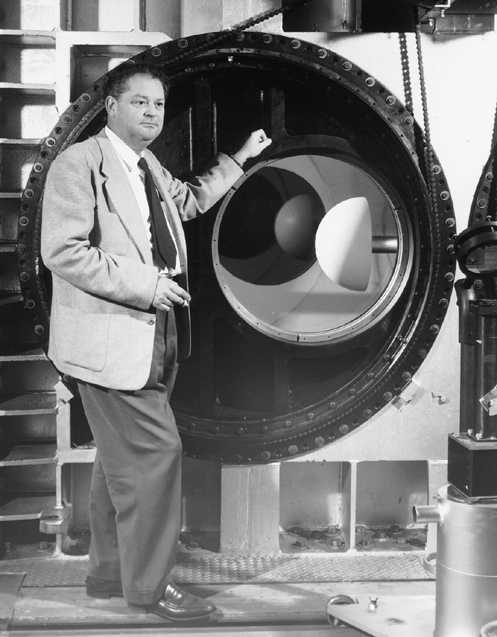Space History Photo: H. Julian Allen

In this historical photo from the U.S. space agency, H. Julian Allen stands beside the observation window of the 8 x 7 foot test section of the NACA Ames Unitary Plan Wind Tunnel in December of 1957.
H. Julian Allen is best known for his "Blunt Body Theory" of aerodynamics, a design technique for alleviating the severe re-entry heating problem which was then delaying the development of ballistic missiles. His findings revolutionized the fundamental design of ballistic missle re-entry shapes.
Subsequently, applied research led to applications of the "blunt" shape to ballistic missles and spacecraft which were intended to re-enter the Earth's atmosphere. This application led to the design of ablative heat shields that protected the Mercury, Gemini and Apollo astronauts as their space capsules re- entered the Earth's atmosphere.
"Harvey" Allen as he was called by most, was not only a brilliant scientist and aeronautical engineer but was also admired for his kindness, thoughtfulness and sense of humor. Among his many other accomplishments, Harvey Allen served as Center Director of the NASA Ames Research Center from 1965 to 1969. He died of a heart attack on January 29, 1977 at the age of 66.
The National Advisory Committee on Aeronautics (NACA) was a precursor to NASA. NACA was created by Congress in 1915.
Each weekday, SPACE.com looks back at the history of spaceflight through photos (archive).
Get the Space.com Newsletter
Breaking space news, the latest updates on rocket launches, skywatching events and more!
Join our Space Forums to keep talking space on the latest missions, night sky and more! And if you have a news tip, correction or comment, let us know at: community@space.com.

The National Aeronautics and Space Administration (NASA) is the U.S. government agency in charge of the civilian space program as well as aeronautics and aerospace research. Founded in 1958, NASA is a civilian space agency aimed at exploring the universe with space telescopes, satellites, robotic spacecraft, astronauts and more. The space agency has 10 major centers based across the U.S. and launches robotic and crewed missions from the Kennedy Space Center in Cape Canaveral Florida. It's astronaut corps is based at the Johnson Space Center in Houston. To follow NASA's latest mission, follow the space agency on Twitter or any other social channel, of visit: nasa.gov.









